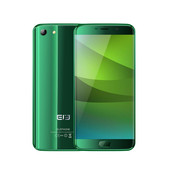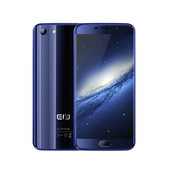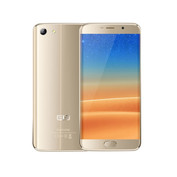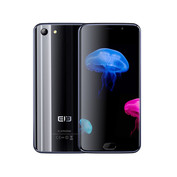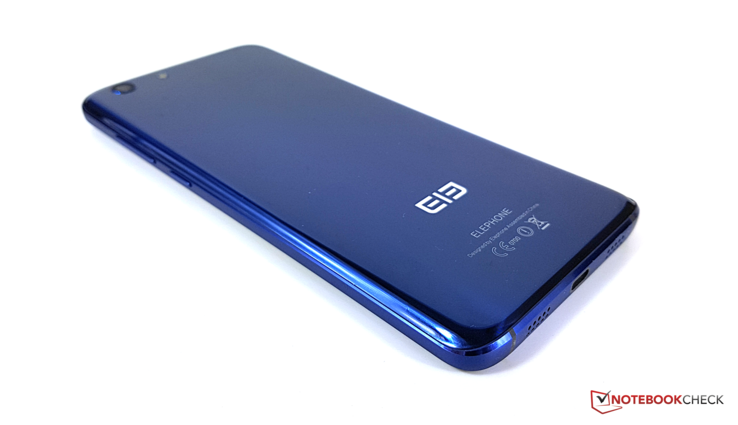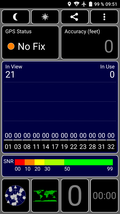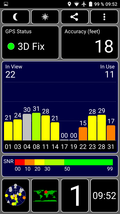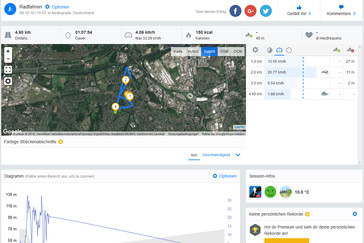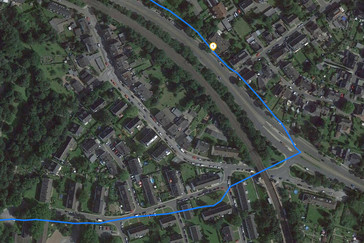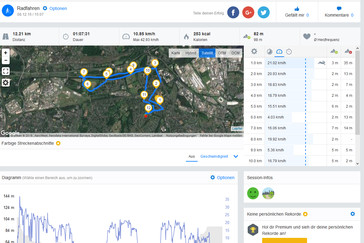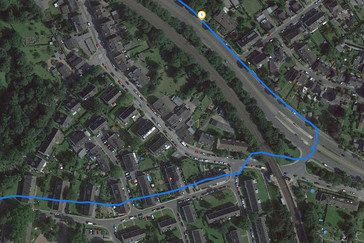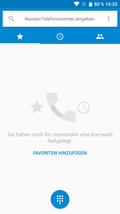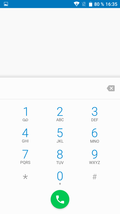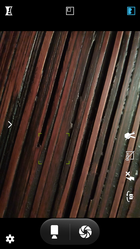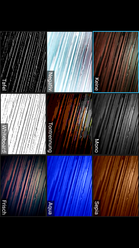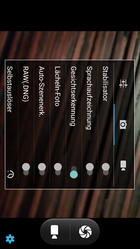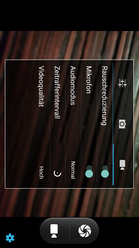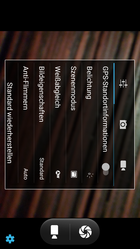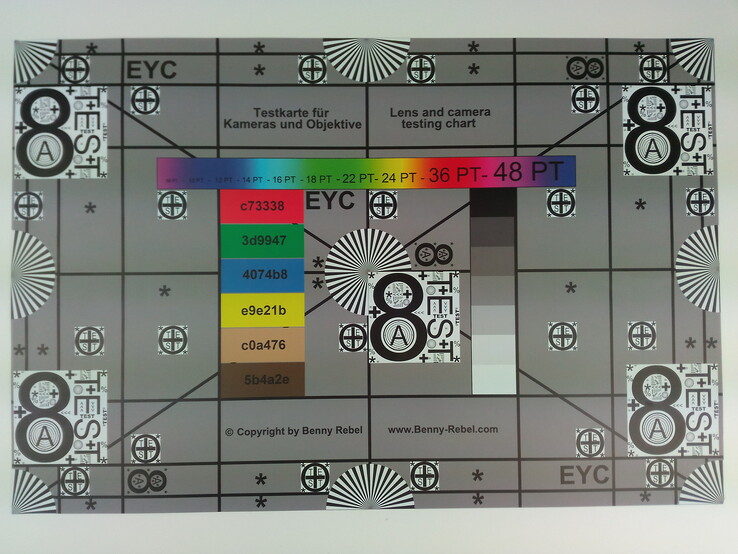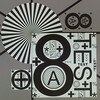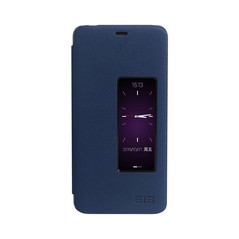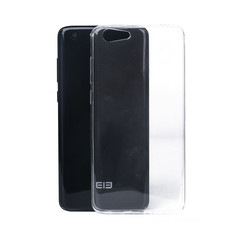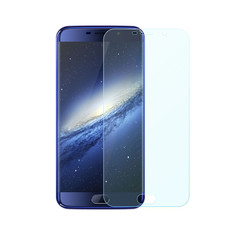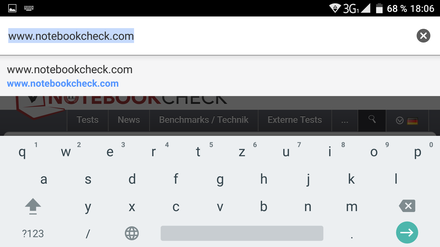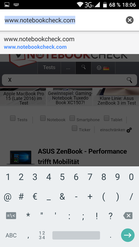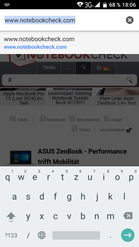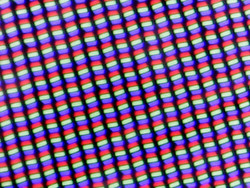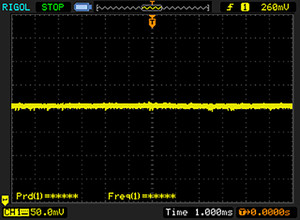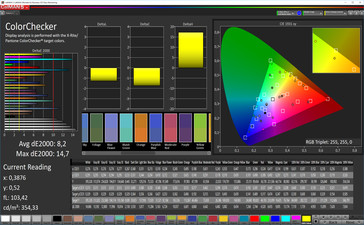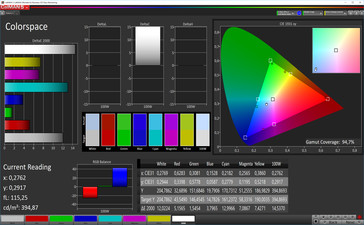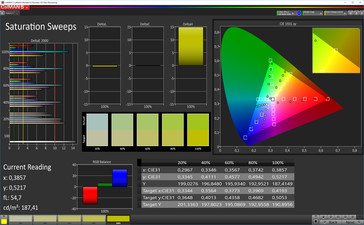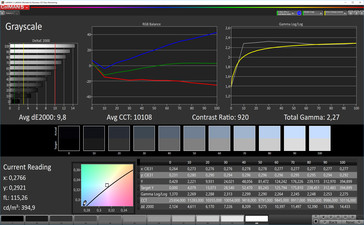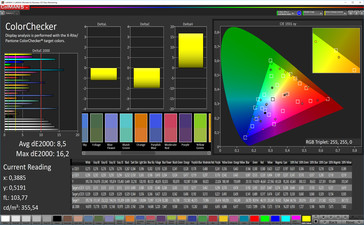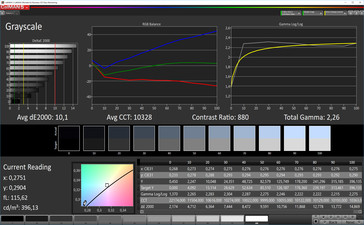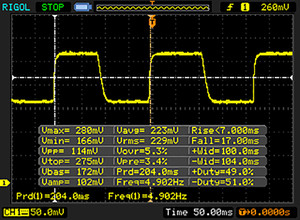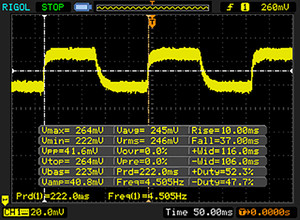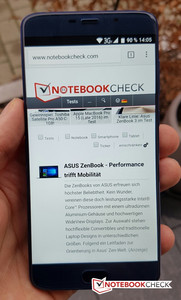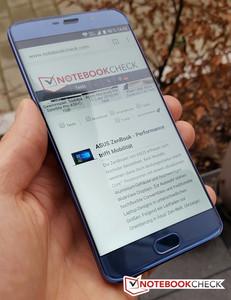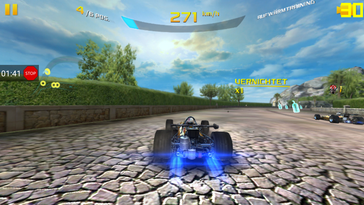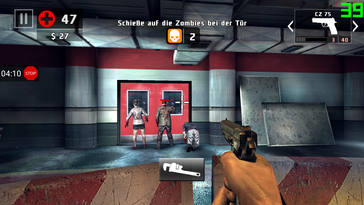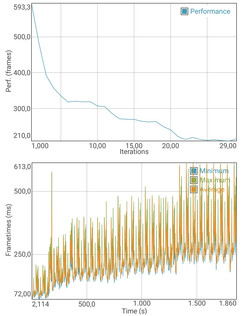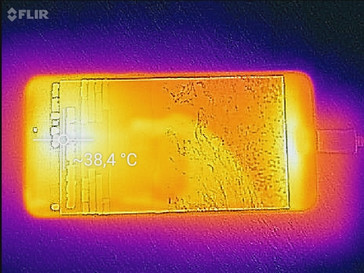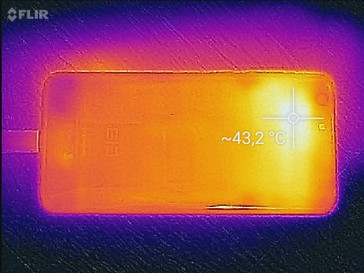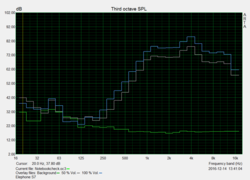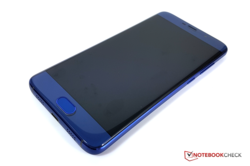ElePhone S7 Smartphone Review

For the original German review, see here.
The latest model of the Chinese smartphone brand ElePhone was officially introduced in November of this year and is available in three versions. The models differ in storage capacity: they start with 2 GB of RAM and 16 GB of flash memory followed by a model with 3 GB of RAM and 32 GB of storage and finally the premium model with 4 GB of working memory and 64 GB of internal storage. The devices look alike - all have the unique selling point of Samsung's Galaxy Edge models, namely the lateral screen. However, a "standard model" without a curved screen is also available (model name: R9).
As well as the laterally curved, 5.5-inch IPS screen with a resolution of 1080p, ElePhone's S7 offers a good technical configuration for a device of this price range. MediaTek's Helio X20 processor provides the needed power inside the smartphone. A 13-MP rear-facing camera and a 5-MP front-facing module are installed. Furthermore, the dual-SIM smartphone has a fingerprint scanner that is hidden in the physical home button. Furthermore, a 3000 mAh battery is incorporated.
The base configuration of the S7 starts at 140 US dollars without shipping, tax, and customs. Roughly 170 Euros (~$178) including shipping is due for the entry-level model in Germany. The models with more memory cost approximately 210 Euros (~$220/3 GB/32 GB) and 220 Euros (~$230/4 GB/64 GB) respectively.
Potential rivals of the mid-range smartphone that we also use for comparison in the test are ZTE's Blade V7, Huawei's 5C, Vernee's Mars, UMi's Super, and Blackview's R7. We will also compare the handset with Samsung's Galaxy S7 Edge due to the undeniable resemblance.
Case
The casing of the mid-range smartphone is made largely of plastic and glass and presents a good build. Unlike Samsung's Galaxy S7 Edge with a glass back, the (thin) plastic rear does not feel as high-quality, although it does not feel cheap. The metal bezel is also rather sharper than its look-alike by Samsung. On the other hand, its rigidity and stability are very good.
With 75.7%, ElePhone's S7 has a somewhat lower screen-surface ratio than Samsung's counterpart (76.1%). Compared with the rivals, this is still a very good rate. By comparison: The screen in Honor's 5C screen only makes up just less than 68.7% of the front. The spacing between the screen and casing is a little too wide, and the glass can be pressed down noticeably. The power and volume button on the casing's right are easy to access. Like the physical home button, they hardly wobble and have a pleasant pressure point.
Similar to Honor's 8, the S7's rear produces striking light patterns that are very nice to look at. It is available in the color options gold, blue, black and green.
Connectivity
The internal eMMC memory in our review sample has a capacity of 64 GB. The user has only 54.1 GB available for personal use in the state of delivery. It is possible to expand the dual-SIM smartphone's storage by up to 128 GB with a microSD card. It can be incorporated into the internal storage via formatting or alternatively compatible apps can be moved to the external memory via App2SD.
The 3000 mAh battery is recharged via the micro-USB 2.0 port on the handset's lower edge. Peripherals such as external keyboards or USB flash drives can be connected via an OTG adapter. Transmitting display content wirelessly to an external monitor via Miracast is also supported and functioned well in the test with a Sony Android TV.
Like Samsung's Galaxy S7 Edge, ElePhone's S7 has a fingerprint scanner integrated into the home button. An LED for incoming notifications is also present.
Software
The manufacturer covers the Android 6.0 Marshmallow operating system with its own E-touch user interface in version 2.0. At the time of testing, the system had the security patch level from August 2016. According to the manufacturer, all ElePhone smartphones will be provided with updates for at least one year. Thus, it is very possible that the S7 model will also be updated to Android Nougat.
The manufacturer's user interface is very similar to that of Google's stock Android and has been modified only slightly. Unnecessary bloatware is not preloaded. Special software features for the lateral edge screen, such as those in Samsung's Galaxy S7, are not provided.
Communication and GPS
The Wi-Fi module integrated into ElePhone's S7 supports the IEEE 802.11 a/b/g/n standard. Thus, not only does it transmit in the 2.4-GHz, but also in the 5-GHz frequency range. We could not connect to the 5.0-GHz Wi-Fi even though it was displayed on ElePhone's handset in the test. It does not support the ac Wi-Fi standard. The Wi-Fi module's reception performance was good and the signal was stable in everyday use. We measured an attenuation of -35 dBm directly beside the router (Telekom Speedport, W921V). The Wi-Fi transmission rate between the smartphone and our Linksys EA 8500 reference router can be called poor with only 58 Mbit/s (iPerf server) and especially 20 Mbit/s (iPerf client). Bluetooth 4.0 is present for wireless communication between mobile end devices – however, an NFC chip for near-field communication is not present.
A nano-SIM and micro-SIM card can be inserted into the dual-SIM smartphone's hybrid slot as long as a memory card is not used. The hybrid slot is not limited to GSM speeds. Overall, the number of supported frequencies is low compared with Samsung's Galaxy S7. The mid-range smartphone uses only LTE Cat.4 (150 Mbit/s downstream, 50 Mbit/s upstream) for connecting to mobile Internet on the go. Honor's 5C offers LTE Cat.6 (300 Mbit/s downstream) here. All frequencies needed in Germany are supported, even the LTE 20 band important for rural areas.
| Networking | |
| iperf3 transmit AX12 | |
| Samsung Galaxy S7 Edge | |
| Elephone S7 | |
| iperf3 receive AX12 | |
| Samsung Galaxy S7 Edge | |
| Elephone S7 | |
| iperf Server (receive) TCP 1 m | |
| Samsung Galaxy S7 Edge | |
| UMI Super Euro Edition | |
| Blackview R7 | |
| Vernee Mars | |
| Honor 5C | |
| iperf Client (transmit) TCP 1 m | |
| Samsung Galaxy S7 Edge | |
| UMI Super Euro Edition | |
| Blackview R7 | |
| Honor 5C | |
| Vernee Mars | |
Mobile localization is realized via GPS and the Russian GLONASS satellite system. The S7 by ElePhone found the current location reliably with an accuracy of approximately 4 meters (~13 ft). A strong enough satellite signal was produced indoors during the test. To test the tracking accuracy of our review sample in practice, we recorded a route using Garmin's Edge 500 GPS bike computer and the smartphone simultaneously for comparison. The S7 presented a lapse in tracking in our GPS test and Runtastic repeatedly stopped recording, although it was relaunched several times. Based on the gathered data, the position detection is mediocre.
Telephone and Call Quality
The call quality of the affordable mid-range handset is very good. Annoying interruptions or reception issues did not occur during test calls in the German Vodafone network. Voices were transmitted clearly and our contact also described our voice as very clear. However, the caller's voice was rather distorted when using the speaker.
The phone app of ElePhone's S7 offers standard Android features such as favorites, calls list, and integrated phone book. A keypad can also be opened for entering phone numbers manually.
Cameras
The Chinese manufacturer does not give much information about the installed camera modules. A 13-MP camera (4160x3120 pixels) with autofocus and single-colored LED flash is incorporated into the rear. The aperture of f/2.2, i.e. the ratio of focal width to diameter, allows capturing quite a lot of light on the CMOS image sensor.
The camera scores with good sharpness and details in daylight, although the pictures have low dynamic, and the objects are darkened significantly. Decent close-up photos can also be taken in good light conditions. The colors look pale and faded. The image noise increases significantly in low-light conditions, and therefore photos present a visible graininess. Details of dark objects are completely lost when using the 13-MP camera.
The lens on the casing's front is not quite as fast with an aperture of f/2.4, and has a resolution of only 5 MP (2592x1944) pixels. As with the primary camera, the photo quality decreases clearly as the light is reduced. Nevertheless, the photos are sufficient for selfie snapshots.
Videos can be recorded at a maximum of 1080p at a frame rate of 30 FPS with ElePhone's smartphone. The video resolution decreases to 720p at 30 FPS when using the front-facing 5-MP camera. The quality is satisfactory, but recordings blur very quickly due to the absence of an image stabilizer.
The color tones are quite accurate compared to the factual reference colors under controlled light conditions. However, brown has too high a red pigment content. The photos with X-Rite ColorChecker Passport (not edited afterward, e.g. manual white balance) taken with the 13-MP camera also exhibit a satisfactory white balance, although it is a bit too cool. To evaluate image sharpness, we photograph our test chart under defined artificial light condition. The image sharpness is good, but the photos blur visibly toward the lateral areas.
Accessories and Warranty
In addition to the modular 10-watt power supply (5 V, 2 A), the S7 comes with a USB cable, a small metal tool for opening the SIM card slot, and the usual brochures. The manufacturer also offers a screen protector and a leather and silicon case for the smartphone as optional accessories.
The S7 comes with a 12-month warranty period. Dos and don'ts concerning purchasing devices from China via import companies can be found here.
Please see our Guarantees, Return Policies & Warranties FAQ too for country-specific information.
Input Devices and Handling
The capacitive touchscreen responds accurately to inputs using up to 5 fingers. We could not observe any accuracy deficiencies even in the lateral areas. However, commands are often implemented with some delay. The smartphone is controlled via the physical/capacitive home button. A short tap prompts the "back" command, and when the home button is pressed down the home screen is opened. Holding down the physical button for a longer moment opens the multitasking view. Alternatively, the typical Android onscreen keys for system navigation can be faded in.
The virtual keyboard convinces with pleasantly large keys; the layout corresponds to Google's standard Android. Furthermore, the Corning Gorilla Glass surface presents agreeable typing and gliding properties.
It is possible to unlock ElePhone's S7 via biometric identification using a fingerprint. The active fingerprint sensor is on the casing's front and is integrated into the home button. The detection rate is very good and clearly adds value in everyday use - unlike other handsets in this price range such as Vernee's Mars. Overall, the vibration mechanism is very strong and distinctive.
Display
The IPS LCD screen by JDI (Japan Display Inc.) has a diagonal of almost 14 centimeters (5.5 inches). This, in conjunction with the resolution of 1920x1080 pixels results in a pixel density of 401 PPI. Although Samsung's Galaxy S7 Edge offers a much higher pixel per inch count (577 PPI), subjectively the mid-range smartphone displays text content crisply even when using small fonts. No pixel structures are visible during normal use and viewing distances.
The LCD achieves a brightness of 391 cd/m² in the center when displaying a pure white screen. Thus, the S7 is not quite as bright as its rivals. The LED backlight reached a maximum rate of 389 cd/m² in our brightness test using the ambient light sensor. The very high minimum brightness of over 204 cd/m² is not typical for a smartphone.
| |||||||||||||||||||||||||
Brightness Distribution: 95 %
Center on Battery: 391 cd/m²
Contrast: 954:1 (Black: 0.41 cd/m²)
ΔE ColorChecker Calman: 8.2 | ∀{0.5-29.43 Ø4.78}
ΔE Greyscale Calman: 9.8 | ∀{0.09-98 Ø5}
Gamma: 2.27
CCT: 10108 K
| Elephone S7 IPS, 1920x1080, 5.5" | ZTE Blade V7 IPS, 1920x1080, 5.2" | Honor 5C IPS, 1920x1080, 5.2" | UMI Super Euro Edition IPS, 1920x1080, 5.5" | Vernee Mars IPS, 1920x1080, 5.5" | Blackview R7 IPS, 1920x1080, 5.5" | Samsung Galaxy S7 Edge Super AMOLED, 2560x1440, 5.5" | |
|---|---|---|---|---|---|---|---|
| Screen | -2% | 15% | 29% | 30% | -14% | 55% | |
| Brightness middle (cd/m²) | 391 | 409 5% | 515 32% | 418 7% | 345 -12% | 552 41% | 554 42% |
| Brightness (cd/m²) | 379 | 411 8% | 498 31% | 410 8% | 339 -11% | 526 39% | 552 46% |
| Brightness Distribution (%) | 95 | 96 1% | 93 -2% | 85 -11% | 85 -11% | 91 -4% | 96 1% |
| Black Level * (cd/m²) | 0.41 | 0.38 7% | 0.49 -20% | 0.31 24% | 0.14 66% | 0.64 -56% | |
| Contrast (:1) | 954 | 1076 13% | 1051 10% | 1348 41% | 2464 158% | 863 -10% | |
| Colorchecker dE 2000 * | 8.2 | 9.4 -15% | 6.2 24% | 4.4 46% | 7.1 13% | 11 -34% | 1.59 81% |
| Colorchecker dE 2000 max. * | 14.7 | 17.6 -20% | 11.4 22% | 6.5 56% | 13.9 5% | 20.8 -41% | 2.56 83% |
| Greyscale dE 2000 * | 9.8 | 11.6 -18% | 7.4 24% | 3.6 63% | 6.7 32% | 14.3 -46% | 2.01 79% |
| Gamma | 2.27 97% | 2.25 98% | 2.28 96% | 2.36 93% | 2.47 89% | 2.21 100% | 2.01 109% |
| CCT | 10108 64% | 9597 68% | 8664 75% | 6993 93% | 7711 84% | 12996 50% | 6321 103% |
| Color Space (Percent of AdobeRGB 1998) (%) | 82.12 | ||||||
| Color Space (Percent of sRGB) (%) | 99.98 |
* ... smaller is better
Screen Flickering / PWM (Pulse-Width Modulation)
| Screen flickering / PWM not detected | |||
In comparison: 53 % of all tested devices do not use PWM to dim the display. If PWM was detected, an average of 8101 (minimum: 5 - maximum: 343500) Hz was measured. | |||
Alongside a black level of 0.41 cd/m², the S7 manages a contrast ratio of 954:1. We recorded the same rate of 391 cd/m² in the realistic display brightness measurement with equally distributed bright and dark areas (APL50 test). The black level remained stable at 0.41 cd/m² and consequently the contrast ratio did not vary.
The color reproduction of the screen in ElePhone's S7 is examined using X-Rite's photospectrometer (i1pro 2) and CalMAN's analysis software. The IPS panel almost completely covers the sRGB color space. The average DeltaE deviation in the grayscales of 9.8 and mixed colors of 8.2 are well above the ideal range of <3. The S7 also clearly surpass the ideal color temperature of 6500 K and the grayscales present a visible bluish tint in bright areas - thus, the image looks a bit too cool.
The average DeltaE deviation in both the grayscale and mixed colors are slightly higher in the vivid display mode.
Display Response Times
| ↔ Response Time Black to White | ||
|---|---|---|
| 23 ms ... rise ↗ and fall ↘ combined | ↗ 7 ms rise | |
| ↘ 17 ms fall | ||
| The screen shows good response rates in our tests, but may be too slow for competitive gamers. In comparison, all tested devices range from 0.1 (minimum) to 240 (maximum) ms. » 51 % of all devices are better. This means that the measured response time is worse than the average of all tested devices (20.2 ms). | ||
| ↔ Response Time 50% Grey to 80% Grey | ||
| 47 ms ... rise ↗ and fall ↘ combined | ↗ 10 ms rise | |
| ↘ 37 ms fall | ||
| The screen shows slow response rates in our tests and will be unsatisfactory for gamers. In comparison, all tested devices range from 0.165 (minimum) to 636 (maximum) ms. » 80 % of all devices are better. This means that the measured response time is worse than the average of all tested devices (31.6 ms). | ||
The viewing angle stability of the installed liquid crystal display is very good. Colors did not invert, and the brightness loss from a lateral view on the screen is minimal. As with Samsung's Galaxy S7, the screen's edges shine much brighter than the rest of the panel from flat viewing angles. Furthermore, some bright spots (clouding) are visible.
Performance
The MediaTek SoC (System on a Chip) inside ElePhone's S7 fits in the upper mid-range. The Helio X20 MT6797 is built in 20 nm, and has 10 CPU cores. Both Cortex A72 cores clock at up to 2.3 GHz in ElePhone's handset and the Cortex A53 cores at a maximum of 1.83 GHz. The integrated Mali T880 (MP4) graphics unit offers 4 clusters of the Midgard architecture. Not very common in this price range, the SoC can fall back on a generous 4 GB of RAM.
Subjectively, the system performance is not on par with that of the rivals despite the very strong Helio X20 SoC. The system mostly runs smoothly in everyday use, but delays and stutters are often the case, particularly during multitasking. Opening and closing applications are also somewhat slow.
The Helio X20 SoC shows its potential in the benchmarks and is on par with Honor's 5C and somewhat better than the Helio P10 rivals. ElePhone's S7 convinces especially in the graphics driven GFX Bench benchmark. However, ElePhone's handset does not come close to the benchmark results of Huawei's P9 Plus with a Mali T880 (MP4). It presents a much weaker graphics performance despite the same GPU.
| AnTuTu v6 - Total Score (sort by value) | |
| Elephone S7 | |
| ZTE Blade V7 | |
| Honor 5C | |
| UMI Super Euro Edition | |
| Vernee Mars | |
| Blackview R7 | |
| Samsung Galaxy S7 Edge | |
| Huawei P9 Plus | |
| Geekbench 4.0 | |
| 64 Bit Single-Core Score (sort by value) | |
| Elephone S7 | |
| UMI Super Euro Edition | |
| Vernee Mars | |
| Blackview R7 | |
| Samsung Galaxy S7 Edge | |
| 64 Bit Multi-Core Score (sort by value) | |
| Elephone S7 | |
| UMI Super Euro Edition | |
| Vernee Mars | |
| Blackview R7 | |
| Samsung Galaxy S7 Edge | |
| GFXBench (DX / GLBenchmark) 2.7 | |
| T-Rex Onscreen (sort by value) | |
| Elephone S7 | |
| ZTE Blade V7 | |
| Honor 5C | |
| UMI Super Euro Edition | |
| Vernee Mars | |
| Blackview R7 | |
| Samsung Galaxy S7 Edge | |
| Huawei P9 Plus | |
| 1920x1080 T-Rex Offscreen (sort by value) | |
| Elephone S7 | |
| ZTE Blade V7 | |
| Honor 5C | |
| UMI Super Euro Edition | |
| Vernee Mars | |
| Blackview R7 | |
| Samsung Galaxy S7 Edge | |
| Huawei P9 Plus | |
| GFXBench 3.0 | |
| on screen Manhattan Onscreen OGL (sort by value) | |
| Elephone S7 | |
| ZTE Blade V7 | |
| Honor 5C | |
| UMI Super Euro Edition | |
| Vernee Mars | |
| Blackview R7 | |
| Samsung Galaxy S7 Edge | |
| Huawei P9 Plus | |
| 1920x1080 1080p Manhattan Offscreen (sort by value) | |
| Elephone S7 | |
| ZTE Blade V7 | |
| Honor 5C | |
| UMI Super Euro Edition | |
| Vernee Mars | |
| Blackview R7 | |
| Samsung Galaxy S7 Edge | |
| Huawei P9 Plus | |
| GFXBench 3.1 | |
| on screen Manhattan ES 3.1 Onscreen (sort by value) | |
| Elephone S7 | |
| ZTE Blade V7 | |
| Honor 5C | |
| UMI Super Euro Edition | |
| Vernee Mars | |
| Blackview R7 | |
| Samsung Galaxy S7 Edge | |
| Huawei P9 Plus | |
| 1920x1080 Manhattan ES 3.1 Offscreen (sort by value) | |
| Elephone S7 | |
| ZTE Blade V7 | |
| Honor 5C | |
| UMI Super Euro Edition | |
| Vernee Mars | |
| Blackview R7 | |
| Samsung Galaxy S7 Edge | |
| Huawei P9 Plus | |
| PCMark for Android - Work performance score (sort by value) | |
| Elephone S7 | |
| ZTE Blade V7 | |
| Honor 5C | |
| UMI Super Euro Edition | |
| Vernee Mars | |
| Blackview R7 | |
| Samsung Galaxy S7 Edge | |
| Huawei P9 Plus | |
The browser speed using the preloaded Chrome browser is very decent both subjectively and objectively (benchmarks). The evident performance differences between the Mozilla Kraken 1.1 and Octane V2 benchmark is striking.
| Mozilla Kraken 1.1 - Total | |
| ZTE Blade V7 | |
| Blackview R7 | |
| UMI Super Euro Edition | |
| Vernee Mars | |
| Honor 5C | |
| Elephone S7 | |
| Samsung Galaxy S7 Edge | |
| Octane V2 - Total Score | |
| Samsung Galaxy S7 Edge | |
| Honor 5C | |
| UMI Super Euro Edition | |
| Vernee Mars | |
| Blackview R7 | |
| Elephone S7 | |
| ZTE Blade V7 | |
| JetStream 1.1 - Total Score | |
| Samsung Galaxy S7 Edge | |
| Elephone S7 | |
| Honor 5C | |
| Vernee Mars | |
| UMI Super Euro Edition | |
| Blackview R7 | |
| ZTE Blade V7 | |
* ... smaller is better
The speed of the internal eMMC storage is not particularly convincing for the price range. Apart from sequential write, the achieved access times are below average. The integrated microSD card slot is also relatively slow. We tested its speed with our Toshiba Exceria Pro M401 (max. read: 95 MB/s, write 80 MB/s) reference card. The slot's performance is at most satisfactory for a mid-range handset with 16 MB/s (read) and 12 MB/s (write).
| Elephone S7 Mali-T880 MP4, Helio X20 MT6797, 64 GB eMMC Flash | ZTE Blade V7 Mali-T720 MP4, MT6753, 16 GB eMMC Flash | Honor 5C Mali-T830 MP2, Kirin 650, 16 GB eMMC Flash | UMI Super Euro Edition Mali-T860 MP2, Helio P10 MT6755, 32 GB eMMC Flash | Vernee Mars Mali-T860 MP2, Helio P10 MT6755, 32 GB eMMC Flash | Blackview R7 Mali-T860 MP2, Helio P10 MT6755, 32 GB eMMC Flash | Samsung Galaxy S7 Edge Mali-T880 MP12, Exynos 8890, 32 GB UFS 2.0 Flash | |
|---|---|---|---|---|---|---|---|
| AndroBench 3-5 | -2% | 56% | 14% | 21% | -5% | 136% | |
| Sequential Write 256KB SDCard (MB/s) | 18.57 | 20.89 12% | 24.21 30% | 17.88 -4% | 24 29% | 11.87 -36% | 50.4 171% |
| Sequential Read 256KB SDCard (MB/s) | 32.86 | 43.67 33% | 51.9 58% | 36.22 10% | 44.5 35% | 15.56 -53% | 76.4 133% |
| Random Write 4KB (MB/s) | 7.89 | 7.58 -4% | 15.7 99% | 11.88 51% | 15.77 100% | 11.4 44% | 15.79 100% |
| Random Read 4KB (MB/s) | 21.8 | 28.07 29% | 61.7 183% | 28.17 29% | 21.66 -1% | 28.02 29% | 86.7 298% |
| Sequential Write 256KB (MB/s) | 167.1 | 39.45 -76% | 75.5 -55% | 126.9 -24% | 71.6 -57% | 122.7 -27% | 145.1 -13% |
| Sequential Read 256KB (MB/s) | 213.8 | 196.8 -8% | 263 23% | 257.8 21% | 255.9 20% | 247.6 16% | 487.3 128% |
Games
The Mali T880 (MP4) graphics unit integrated into the high-performance MediaTek SoC allows playing even more sophisticated 3D games from the Android Play Store smoothly to a large degree. Up-to-date games such as the racing game "Asphalt 8: Airborne" and the first-person shooter "Dead Trigger 2" are rendered at relatively stable 27 FPS and 34 FPS using high graphic settings. As in the benchmarks, Huawei P9 Plus achieves high FPS rates also in the gaming test.
Handling is no problem thanks to the well-functioning sensors and the screen's satisfactory input accuracy.
| Dead Trigger 2 | |||
| Settings | Value | ||
| high | 34 fps | ||
| Asphalt 8: Airborne | |||
| Settings | Value | ||
| high | 27 fps | ||
| very low | 30 fps | ||
Emissions
Temperature
The surface temperatures of ElePhone's S7 remain at a moderate level while idling. With an average of 29.6 °C (~85 °F) on the back, it is situated in the lower midfield among its rivals. This is also true for its waste heat during load. We measured an average temperature of 36 °C (~97 °F) on the back, which is comparable with Honor's 5C (34.9 °C/~95 °F) or Vernee's Mars (35.1 °C/~95 °F). The rear upper area of ElePhone's S7 heats up noticeably, but it never gets unpleasantly hot.
Based on the battery test using the GFXBench app, it becomes obvious that both the battery state as well as the frame rates drop very quickly - the Helio X20 SoC's performance is more than halved after performing the Manhattan 3.1 test thirty times in succession.
(+) The maximum temperature on the upper side is 37.5 °C / 100 F, compared to the average of 35.2 °C / 95 F, ranging from 21.9 to 247 °C for the class Smartphone.
(±) The bottom heats up to a maximum of 42.4 °C / 108 F, compared to the average of 34 °C / 93 F
(+) In idle usage, the average temperature for the upper side is 30.5 °C / 87 F, compared to the device average of 32.9 °C / 91 F.
Speaker
Generally, the mono speaker's maximum volume of almost 91 dB(A) is very loud. The produced sound quality, however, has to be classified as not so good. The diagram of our Pink Noise measurement illustrates that a very low volume is achieved, especially in the bass range. Furthermore, the entire audible range is not very linear. A tinny, extremely low-bass sound has to be accepted, particularly at high volumes in everyday use. Music fans should preferably opt for another smartphone such as Alcatel's One Touch Pop 4S.
It is recommended to use headphones via the 3.5-millimeter audio jack for a higher-quality music experience with less noise.
Elephone S7 audio analysis
(+) | speakers can play relatively loud (90.5 dB)
Bass 100 - 315 Hz
(-) | nearly no bass - on average 43.9% lower than median
(+) | bass is linear (6.4% delta to prev. frequency)
Mids 400 - 2000 Hz
(±) | reduced mids - on average 9.8% lower than median
(±) | linearity of mids is average (8.7% delta to prev. frequency)
Highs 2 - 16 kHz
(+) | balanced highs - only 4.5% away from median
(+) | highs are linear (5.1% delta to prev. frequency)
Overall 100 - 16.000 Hz
(±) | linearity of overall sound is average (29.1% difference to median)
Compared to same class
» 76% of all tested devices in this class were better, 3% similar, 21% worse
» The best had a delta of 11%, average was 35%, worst was 134%
Compared to all devices tested
» 87% of all tested devices were better, 2% similar, 11% worse
» The best had a delta of 4%, average was 24%, worst was 134%
Samsung Galaxy S7 Edge audio analysis
(+) | speakers can play relatively loud (88.7 dB)
Bass 100 - 315 Hz
(-) | nearly no bass - on average 27.4% lower than median
(±) | linearity of bass is average (8.7% delta to prev. frequency)
Mids 400 - 2000 Hz
(+) | balanced mids - only 4.4% away from median
(+) | mids are linear (4.7% delta to prev. frequency)
Highs 2 - 16 kHz
(±) | higher highs - on average 5.8% higher than median
(+) | highs are linear (6.2% delta to prev. frequency)
Overall 100 - 16.000 Hz
(±) | linearity of overall sound is average (20.6% difference to median)
Compared to same class
» 35% of all tested devices in this class were better, 9% similar, 56% worse
» The best had a delta of 11%, average was 35%, worst was 134%
Compared to all devices tested
» 54% of all tested devices were better, 8% similar, 38% worse
» The best had a delta of 4%, average was 24%, worst was 134%
Honor 5C audio analysis
(+) | speakers can play relatively loud (87.9 dB)
Bass 100 - 315 Hz
(-) | nearly no bass - on average 30.9% lower than median
(±) | linearity of bass is average (8.1% delta to prev. frequency)
Mids 400 - 2000 Hz
(±) | higher mids - on average 7.1% higher than median
(±) | linearity of mids is average (8.8% delta to prev. frequency)
Highs 2 - 16 kHz
(±) | higher highs - on average 12.1% higher than median
(+) | highs are linear (2.9% delta to prev. frequency)
Overall 100 - 16.000 Hz
(-) | overall sound is not linear (31.7% difference to median)
Compared to same class
» 81% of all tested devices in this class were better, 2% similar, 16% worse
» The best had a delta of 11%, average was 35%, worst was 134%
Compared to all devices tested
» 90% of all tested devices were better, 2% similar, 8% worse
» The best had a delta of 4%, average was 24%, worst was 134%
Frequency diagram in comparison (checkboxes above can be turned on/off!)
Energy Management
Power Consumption
The power consumption of ElePhone's S7 does not seem to have been optimized much, especially during load. Except for Blackview's R7, the rivals are considerably more efficient in our measurements - particularly, ZTE's Blade V7.
| Off / Standby | |
| Idle | |
| Load |
|
Key:
min: | |
| Elephone S7 3000 mAh | ZTE Blade V7 2540 mAh | Honor 5C 3000 mAh | UMI Super Euro Edition 4000 mAh | Vernee Mars 3000 mAh | Blackview R7 3000 mAh | Samsung Galaxy S7 Edge 3600 mAh | |
|---|---|---|---|---|---|---|---|
| Power Consumption | 45% | 24% | 14% | 23% | -29% | 33% | |
| Idle Minimum * (Watt) | 1.42 | 0.73 49% | 0.89 37% | 0.84 41% | 1.02 28% | 1.83 -29% | 0.63 56% |
| Idle Average * (Watt) | 1.87 | 0.92 51% | 2.07 -11% | 1.94 -4% | 1.69 10% | 3.21 -72% | 1.1 41% |
| Idle Maximum * (Watt) | 2.11 | 0.93 56% | 2.15 -2% | 2.07 2% | 1.82 14% | 3.45 -64% | 1.56 26% |
| Load Average * (Watt) | 6.16 | 4.47 27% | 3.46 44% | 5.88 5% | 4.39 29% | 5.67 8% | 5.95 3% |
| Load Maximum * (Watt) | 10.67 | 5.96 44% | 5.18 51% | 7.67 28% | 6.79 36% | 9.16 14% | 6.7 37% |
* ... smaller is better
Battery Runtime
The non-removable lithium ion polymer battery has a nominal output of 3000 mAh. The mid-range handset places itself far behind its rivals with 3 hours and 43 minutes in our Wi-Fi test. However, these rates are only conditionally comparable due to ElePhone's S7 minimum brightness of 204 cd/m² since the standard screen brightness of 150 cd/m² for this test is clearly surpassed. We measured a relatively decent runtime of 2 hours and 48 minutes during load. On the other hand, the short runtimes during permanent video playback and while idling reflect the inefficient energy management in the partial load range.
The included power supply can provide up to 10 watts (5 V, 2 A), and recharges the battery in ElePhone's S7 fully within almost 1.5 hours. Compared with the rivals, the charging time is relatively short.
| Elephone S7 3000 mAh | ZTE Blade V7 2540 mAh | Honor 5C 3000 mAh | UMI Super Euro Edition 4000 mAh | Vernee Mars 3000 mAh | Blackview R7 3000 mAh | Samsung Galaxy S7 Edge 3600 mAh | |
|---|---|---|---|---|---|---|---|
| Battery runtime | 135% | 85% | 172% | 92% | 86% | 194% | |
| Reader / Idle (h) | 8.1 | 16.6 105% | 20.9 158% | 27.7 242% | |||
| H.264 (h) | 5.6 | 10 79% | 15.2 171% | ||||
| WiFi v1.3 (h) | 3.7 | 8.7 135% | 9.7 162% | 10.6 186% | 7.1 92% | 6.9 86% | 12.2 230% |
| Load (h) | 2.8 | 2.6 -7% | 6.5 132% |
Pros
Cons
Verdict
If we had to summarize ElePhone's S7 in one sentence, our exaggerated verdict would be: Nice to look at, but not much substance underneath.
The casing's looks and build are very good for the price range. The IPS panel is sharp enough and sufficiently bright for everyday use. We also quite liked the call quality and the well-functioning fingerprint sensor.
The short battery life, caused by the inefficient energy management on the one hand and the screen's very high minimum brightness on the other, do not speak for ElePhone's smartphone. Furthermore, the performance is not on par with the direct rivals, despite the high-performance MediaTek's SoCs. Other points of criticism, such as the slow system memory, the mediocre camera and speaker quality, and the Wi-Fi module's low transmission rates, do not result in a rounded total concept. In our opinion, the Honor 5C or Vernee Mars (both available in Germany via import companies) are better alternatives.
The original will be needed for a Galaxy S7 feel - at least ElePhone's S7 is not really an alternative. Even compared with direct competitors, the mid-range smartphone did not entirely convince us.
Elephone S7
- 12/22/2016 v6 (old)
Marcus Herbrich




